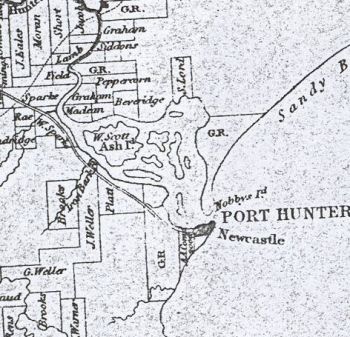James St. John Ranclaud - Settler
Map 1
Captain James St. John Ranclaud, wife and five children arrived on the Pyramus from London in May 1829. Lieutenant William Caswell and family also arrived on this vessel.
Land Grant
 Captain Ranclaud received a grant of 2560 acres in 1829. The grant was issued under military tenure as he had served over 20 years as an Officer in the British service and was to be without quit rent forever. [3]
Captain Ranclaud received a grant of 2560 acres in 1829. The grant was issued under military tenure as he had served over 20 years as an Officer in the British service and was to be without quit rent forever. [3]The grant ran west to Killingworth and the Sugarloaf Range.[4] The location of his land grant can be found in part on the map below on the lower left side just below the grant to George Weller. Map is interactive. Click on any of the names to find other settlers in the area
In 1830 he selected a further 914 acres of land which ran south from the Five Islands to Marmong Creek and adjoined his first grant. On Captain Ranclaud's death the 914 acre grant was transferred to James Mitchell. This land in part was bequeathed to James Mitchell's daughter Margaret Scott Quigley.[4]
The Cathedral Cemetery
The following article about Captain James St. John Ranclaud was published in the Newcastle Morning Herald in 1902.
Over 70 years ago, near the banks of Cockle Creek there stood a comfortable homestead surrounded by some 6000 acres of land, the property of Captain James St. John Ranclaud.
The old homestead has long since passed away, and few who know the present township of Teralba would realise that in years gone by flocks of sheep, horses, and cattle were successfully reared and fattened here.
Captain Ranclaud was an officer of the Old Pompadours (56th) now merged into the Essex Regiment, and after considerable service in India, retired from the Army and came to NSW in 1825. He secured land in the locality of Teralba, the homestead was originally called Trialba - and at once set himself to improve the place and establish a station. His wife, who was a daughter of colonel Boscawen, and niece of the admiral of that name, accompanied him, and shared the exigencies of pioneer life in what was then a wild country.
The homestead, in common with all others, was worked with assigned servants but the captain was a humane man, and while exacting obedience neither allowed nor practiced cruelty to prisoners which was so common in the early days. His treatment of the men was reciprocated for in the thirties when escaped prisoners were raiding the bush in every direction, Trialba enjoyed immunity from attack.
As a pastoralist Captain Ranclaud ranked among the pioneers in the Northern district. A firm believer in the ultimate future of the wool growing industry, he imported sheep from Germany at the same time the A.A. Co brought out the animals which formed the basis of the magnificent flocks they own today both lots of sheep being in quarantine together.
He died at Newcastle in 1832, having had a paralytic seizure twelve months previously from which he never recovered, and his remains were interred in the churchyard where by his side in later years Captain Biddulph was buried. The vault is covered by a plain stone on which is inscribed - Sacred to the memory of James St. John Ranclaud who departed this life May 29 1832, in the 46 years of his life and Susanna wife of the above who departed this life December 23 1861 aged 72.
Captain Ranclaud left three sons, the eldest being the late Mr. James John Ranclaud, father of Lieut-Col Ranclaud, District Commandant and Messrs, John, Hugh and Bruce Ranclaud. The second son married Miss Biddulph, whose sons Messrs. J.S. and B. Ranclaud are also well known. It was due to personal friendship that another military settler Lieut. Caswell came to Australia and settled at Soldiers Point Port Stephens where he like Captain Ranclaud received a grant of land . [1]
The Trialba Estate was offered for lease in 1855 and was said to comprise about 3000 acres suitable for agricultural and dairy purposes. Improvements on the Estate consisted of a neat weather boarded cottage, containing 5 rooms, a good stockyard, several enclosed paddocks with garden ground attached. Fifty acres had been cleared. [2]
References
[1] Newcastle Morning Herald 4 April 1902[2] Maitland Mercury 8 September 1855
[3] Ancestry.com. State Records Authority of New South Wales; Kingswood, New South Wales, Australia; Returns of the Colony ('Blue Books'), 1822-1857; Collection Number: Series 1286; Publication Year: 1829
↑
